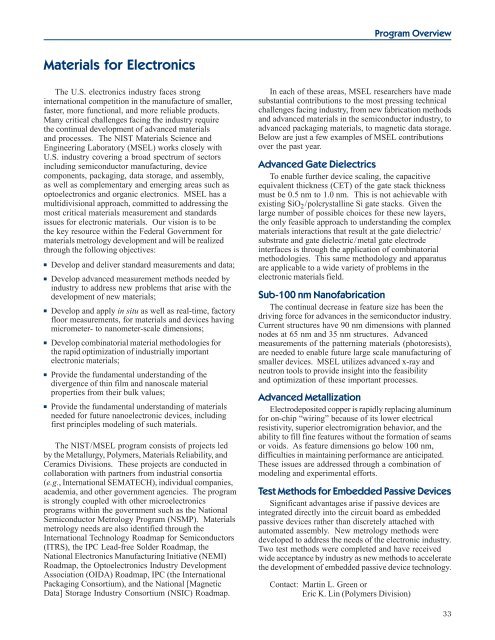Materials Science and Engineering Laboratory FY 2004 ... - NIST
Materials Science and Engineering Laboratory FY 2004 ... - NIST
Materials Science and Engineering Laboratory FY 2004 ... - NIST
You also want an ePaper? Increase the reach of your titles
YUMPU automatically turns print PDFs into web optimized ePapers that Google loves.
<strong>Materials</strong> for Electronics<br />
The U.S. electronics industry faces strong<br />
international competition in the manufacture of smaller,<br />
faster, more functional, <strong>and</strong> more reliable products.<br />
Many critical challenges facing the industry require<br />
the continual development of advanced materials<br />
<strong>and</strong> processes. The <strong>NIST</strong> <strong>Materials</strong> <strong>Science</strong> <strong>and</strong><br />
<strong>Engineering</strong> <strong>Laboratory</strong> (MSEL) works closely with<br />
U.S. industry covering a broad spectrum of sectors<br />
including semiconductor manufacturing, device<br />
components, packaging, data storage, <strong>and</strong> assembly,<br />
as well as complementary <strong>and</strong> emerging areas such as<br />
optoelectronics <strong>and</strong> organic electronics. MSEL has a<br />
multidivisional approach, committed to addressing the<br />
most critical materials measurement <strong>and</strong> st<strong>and</strong>ards<br />
issues for electronic materials. Our vision is to be<br />
the key resource within the Federal Government for<br />
materials metrology development <strong>and</strong> will be realized<br />
through the following objectives:<br />
■ Develop <strong>and</strong> deliver st<strong>and</strong>ard measurements <strong>and</strong> data;<br />
■ Develop advanced measurement methods needed by<br />
industry to address new problems that arise with the<br />
development of new materials;<br />
■ Develop <strong>and</strong> apply in situ as well as real-time, factory<br />
floor measurements, for materials <strong>and</strong> devices having<br />
micrometer- to nanometer-scale dimensions;<br />
■ Develop combinatorial material methodologies for<br />
the rapid optimization of industrially important<br />
electronic materials;<br />
■ Provide the fundamental underst<strong>and</strong>ing of the<br />
divergence of thin film <strong>and</strong> nanoscale material<br />
properties from their bulk values;<br />
■ Provide the fundamental underst<strong>and</strong>ing of materials<br />
needed for future nanoelectronic devices, including<br />
first principles modeling of such materials.<br />
The <strong>NIST</strong>/MSEL program consists of projects led<br />
by the Metallurgy, Polymers, <strong>Materials</strong> Reliability, <strong>and</strong><br />
Ceramics Divisions. These projects are conducted in<br />
collaboration with partners from industrial consortia<br />
(e.g., International SEMATECH), individual companies,<br />
academia, <strong>and</strong> other government agencies. The program<br />
is strongly coupled with other microelectronics<br />
programs within the government such as the National<br />
Semiconductor Metrology Program (NSMP). <strong>Materials</strong><br />
metrology needs are also identified through the<br />
International Technology Roadmap for Semiconductors<br />
(ITRS), the IPC Lead-free Solder Roadmap, the<br />
National Electronics Manufacturing Initiative (NEMI)<br />
Roadmap, the Optoelectronics Industry Development<br />
Association (OIDA) Roadmap, IPC (the International<br />
Packaging Consortium), <strong>and</strong> the National [Magnetic<br />
Data] Storage Industry Consortium (NSIC) Roadmap.<br />
Program Overview<br />
In each of these areas, MSEL researchers have made<br />
substantial contributions to the most pressing technical<br />
challenges facing industry, from new fabrication methods<br />
<strong>and</strong> advanced materials in the semiconductor industry, to<br />
advanced packaging materials, to magnetic data storage.<br />
Below are just a few examples of MSEL contributions<br />
over the past year.<br />
Advanced Gate Dielectrics<br />
To enable further device scaling, the capacitive<br />
equivalent thickness (CET) of the gate stack thickness<br />
must be 0.5 nm to 1.0 nm. This is not achievable with<br />
existing SiO 2/polcrystalline Si gate stacks. Given the<br />
large number of possible choices for these new layers,<br />
the only feasible approach to underst<strong>and</strong>ing the complex<br />
materials interactions that result at the gate dielectric/<br />
substrate <strong>and</strong> gate dielectric/metal gate electrode<br />
interfaces is through the application of combinatorial<br />
methodologies. This same methodology <strong>and</strong> apparatus<br />
are applicable to a wide variety of problems in the<br />
electronic materials field.<br />
Sub-100 nm Nanofabrication<br />
The continual decrease in feature size has been the<br />
driving force for advances in the semiconductor industry.<br />
Current structures have 90 nm dimensions with planned<br />
nodes at 65 nm <strong>and</strong> 35 nm structures. Advanced<br />
measurements of the patterning materials (photoresists),<br />
are needed to enable future large scale manufacturing of<br />
smaller devices. MSEL utilizes advanced x-ray <strong>and</strong><br />
neutron tools to provide insight into the feasibility<br />
<strong>and</strong> optimization of these important processes.<br />
Advanced Metallization<br />
Electrodeposited copper is rapidly replacing aluminum<br />
for on-chip “wiring” because of its lower electrical<br />
resistivity, superior electromigration behavior, <strong>and</strong> the<br />
ability to fill fine features without the formation of seams<br />
or voids. As feature dimensions go below 100 nm,<br />
difficulties in maintaining performance are anticipated.<br />
These issues are addressed through a combination of<br />
modeling <strong>and</strong> experimental efforts.<br />
Test Methods for Embedded Passive Devices<br />
Significant advantages arise if passive devices are<br />
integrated directly into the circuit board as embedded<br />
passive devices rather than discretely attached with<br />
automated assembly. New metrology methods were<br />
developed to address the needs of the electronic industry.<br />
Two test methods were completed <strong>and</strong> have received<br />
wide acceptance by industry as new methods to accelerate<br />
the development of embedded passive device technology.<br />
Contact: Martin L. Green or<br />
Eric K. Lin (Polymers Division)<br />
33

















